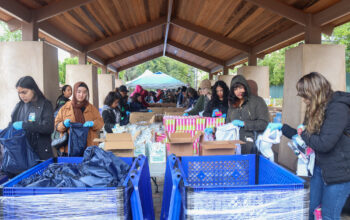
More than 25 horses owned by Hidden Valley residents were ordered to evacuate their homes, due to the blazing Springs fire and taken to Pierce College’s Equestrian Center over the first weekend of May.
As a school with the amenities to keep horses on campus, Pierce plays a part in a network of Southland facilities that work with emergency crews and haulers to aid with large animal evacuations, according to Betsy Connolly, a horse science instructor who helped organize the evacuation.
“We all coordinated because we know we can’t keep people safe unless there is a plan to keep their horses safe,” she said. “Horse owners will not leave their precious horses behind.”
The 28,000-acre Springs fire, which spread across Ventura County, damaged 15 homes and resulted in mandatory evacuations, according to the Los Angeles Times.
Pierce Instructor of Arts Monika Del Bosque lives in Newbury Park, about a block away from where mandatory evacuations began, she said in an email. She said that she voluntarily evacuated twice due to the blaze.
“I could have gotten very afraid about losing my possessions, but it’s just stuff in the end,” Del Bosque said in the email. “I was more concerned about hwo it would have impacted my children and their loss of possessions. But for me, it’s just material goods. Everything is replaceable in the end. The things that aren’t—they’re fleeting.”
Meanwhile, at the Equestrian Center, a map was set up by a registration table to help identify where each horse was kept. Horses were catalogued and assigned ID tags for organization. Stalls were zip tied and buckets of water were set up for each enclosure.
Connolly said that the evacuation alert was issued at approximately 2 p.m. on Friday, May 3, and that shortly after, she received the call to start the temporary sheltering process.
“[The fire and sheriff’s departments] made the decision to open up Pierce,” she said.
The threat subsided sometime around Saturday evening, and the horses were taken back by the haulers Sunday.
“Fortunately, the weather cooperated once the sun went down,” Connolly said.
Though the school provides the evacuation site facilities, the LA County oversees the process.
“The county has jurisdiction. We just worked for them,” Warner said.
Student and faculty volunteers worked with an emergency evacuation team to keep the process of sheltering the horses as smoothly as possible.
In addition to volunteer workers and the facility, Pierce provided food and water for the horses, according to Samantha Gartsman, president of the Boots and Saddles Club.
“We could have anywhere from 100 to 300 horses,” said Jim Brown, one of the security officers on campus who helped out with the evacuation, on Friday.
However, because not much of LA county was affected by the Springs fire–evacuation sites are selected depending on the location of the emergency–there weren’t many horses sent to Pierce, according to Assistant Professor of Horse Science Paddy Warner.
Lori Seely, from the LA County Animal Care and Control Volunteer Equine Response Team, says that she has worked with the Pierce team “a thousand times.” She applauds the campus team on their ability to keep up with the emergency situation.
“They’re amazing,” Seely said.
There weren’t many volunteers immediately available to help out because of the Friday evacuation alert.
“That’s nobody’s fault. Nobody knew this was going to happen,” Seely said.
Regardless, the process went smoothly, according to volunteers.
“If my horse ever had to be evacuated, just seeing how well they’re taken care of here,” said Agricultural Assistant Randi Katz. “I would want them here.”
Incidentally, the weekend was also the first time Pierce hosted a 4-H youth development event, which included equine competitions planned for the arenas in the Equestrian Center. For the event, approximately 20 horses were kept in one of the barns on site.
“I feel like it was a double whammy for us,” Katz said. “We tried to get them accommodated [at the same time as the evacuation].”
It has been two or three years since the campus was last used as an evacuation center for displaced animals.
“California has the best emergency response system in the world,” Connolly said. “Everybody knows where to go, what to do and how to do it.”



